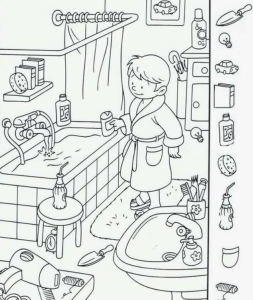I Spy Challenge: Can You Find These Hidden Objects?
“I Spy” has long been a favorite pastime for children and adults alike. Whether it’s flipping through illustrated puzzle books, playing games on a road trip, or diving into online challenges, the thrill of spotting hidden objects keeps our eyes sharp and our minds focused. These puzzles aren’t just fun—they train our brains, boost observation skills, and bring out a competitive spirit in anyone who dares to take the challenge.
Today, we’re going on a deep dive into the world of “I Spy.” This challenge will push your attention to detail, test your patience, and make you rethink how carefully you really look at the world around you. By the end, you’ll not only feel entertained but also sharper and more observant. Let’s explore how the game works, why it’s so popular, and then set you up with a hidden-object challenge of your own.
The History of “I Spy”
The origins of “I Spy” go back centuries. Before it became a puzzle book series or an app, it was a simple spoken game. Traditionally, one player would say, “I spy with my little eye, something beginning with…” and then choose the first letter of the object they had in mind. The other players would scan their surroundings, guessing until the mystery item was found.
By the late 20th century, “I Spy” evolved into colorful picture books with pages crammed full of illustrations where readers had to locate hidden items listed in rhymes. These books, popular in schools and homes, combined language play with visual puzzles, making learning feel like a game. Eventually, digital adaptations popped up in the form of computer games, apps, and interactive online challenges.
Today, “I Spy” thrives on social media, where images filled with camouflaged objects are shared and people race to solve them before their friends do. What started as a spoken guessing game has become a global puzzle phenomenon.
Why Do We Love Hidden Object Challenges?
-
The Thrill of Discovery
There’s something deeply satisfying about scanning a crowded image, believing an object is impossible to find, and then—suddenly—spotting it. That moment of triumph fuels our motivation to keep searching. -
Brain Exercise
These puzzles sharpen focus, improve attention to detail, and boost visual memory. Scientists have shown that exercises requiring close observation can strengthen cognitive pathways. -
Stress Relief
Oddly enough, while they can be challenging, many people find “I Spy” relaxing. Immersing yourself in a colorful picture full of objects pulls your attention away from daily stress and anchors you in the present. -
Friendly Competition
Whether it’s siblings on a road trip or coworkers sharing a puzzle during lunch break, “I Spy” brings out our playful competitive side. Who can find all the items the fastest? -
Accessible Fun
Unlike video games or sports, no equipment or special skill is needed. Anyone, young or old, can join in the challenge.
How to Play the “I Spy” Challenge
There are many ways to play, but the basic steps are simple:
-
Choose or Create a Picture – It could be a cluttered desk, a busy street, a detailed drawing, or even your living room.
-
Make a List – Write down the objects that players need to find. Some can be obvious, while others should be sneaky and hidden in plain sight.
-
Set the Rules – Decide if you’ll race against the clock, take turns, or simply keep searching until all items are discovered.
-
Spot the Objects – Keep your eyes sharp. Remember, some items may be partially hidden, upside down, or disguised by their surroundings.
-
Celebrate the Wins – Every found object is a little victory.
Your “I Spy” Challenge
Now it’s time to put your skills to the test. Imagine the following picture:
A large, bustling carnival scene fills the page. Bright tents stretch across the background, colorful balloons float in the sky, and dozens of people mill about enjoying games, rides, and food stalls. Somewhere in this vibrant illustration, the following hidden objects are waiting for you to find:
-
A tiny green frog sitting on top of a carousel horse.
-
A red balloon caught in the branches of a tall tree.
-
A pair of sunglasses lying on the ground near the popcorn stand.
-
A striped sock dangling from the Ferris wheel.
-
A golden key cleverly tucked into the design of a clown’s costume.
-
A slice of pizza balanced on a bench.
-
A blue umbrella poking out from behind the cotton candy cart.
-
A toy robot hidden among the prizes at the ring toss booth.
-
A yellow duck floating in the dunk tank.
-
A silver watch strapped to the wrist of a balloon vendor.
At first glance, you may think these objects will be easy to spot, but remember: the artist has disguised them well. The frog might blend into the carousel’s paint, the sock might look like a decoration, and the key could vanish into the clown’s busy costume. Take your time and imagine scanning the picture inch by inch.
Tips for Success
-
Break the Scene Into Sections
Don’t try to look everywhere at once. Focus on one corner of the picture, then move to the next. -
Look for Odd Shapes
Hidden objects often stand out not by color but by shape. A round watch face or a duck silhouette might be your best clue. -
Use Color to Your Advantage
If you’re searching for a blue umbrella, let your eyes sweep across the scene for any splash of blue that stands out. -
Zoom In Mentally
Imagine leaning closer to inspect small details. Many objects are tiny and designed to escape a quick glance. -
Stay Patient
The best part of “I Spy” is the hunt itself. If you don’t spot something immediately, keep scanning. The “aha!” moment is worth it.
The Deeper Value of “I Spy”
While “I Spy” is undoubtedly entertaining, it also teaches valuable life skills. In an age where distractions are constant—buzzing phones, endless notifications, multitasking demands—the ability to focus deeply is rare. Playing hidden-object games helps strengthen that muscle of concentration.
For children, these challenges improve vocabulary, as they associate words with pictures, and enhance problem-solving skills. For adults, they can sharpen the mind, reduce stress, and even serve as a bonding activity with friends or family.
Even workplaces have begun using similar puzzles as team-building exercises. They encourage collaboration, patience, and creative thinking. In this way, “I Spy” goes far beyond being just a pastime—it’s a tool for mental fitness and social connection.
Final Thoughts
The “I Spy Challenge” may seem simple, but its magic lies in how it transforms ordinary observation into extraordinary discovery. Whether you’re flipping through a puzzle book, playing with kids on a road trip, or scrolling through an image online, the hunt for hidden objects offers timeless fun and endless benefits.
So, the next time you’re faced with a busy picture filled with color and detail, remember: the objects are there, waiting to be found. All it takes is patience, a sharp eye, and the thrill of the chase.
Are you ready? Look closely, take a deep breath, and begin your search. Because in the world of “I Spy,” the challenge never ends—and every victory, no matter how small, feels like a triumph.



